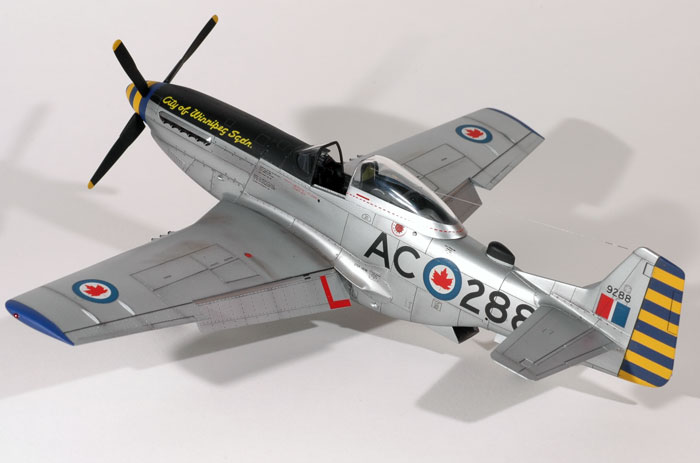Tamiya's 1/48 scale P-51D
Mustang Mk.IV
by Randy Lutz
|

|
North American Mustang Mk.IV |

Tamiya's 1/48 scale P-51D is available online from Squadron
Here is Tamiya's 1/48 scale North American P-51D Mustang finished to represent a post-war Royal Canadian Air Force Mustang Mk. IV from 402 Squadron (Auxiliary) while stationed at Stevenson Field, Winnipeg, Manitoba during 1953.
When the post-war RCAF first received its Mustangs, all were delivered in natural metal, sporting full USAF markings and it was the 10 Repair Depot in Gimly, Manitoba which was tasked with removing the USAF markings and applying RAF Type "C" roundels and fin flashes. Shortly after that, standardized RCAF markings consisting of maple leaf roundels, revised fin flash and three-letter squadron/aircraft identifiers began to appear. In 1950, the upkeep of the natural metal finish proved too time consuming and as a result, the Mustangs were painted overall with silver lacquer. An easy way to spot a silver lacquer Mustang is to look at the panels around the exhaust manifolds. If they appear to be the same tonal value as the remainder of the airframe, then in all likelihood the aircraft is painted silver. In 1952, the three-letter identifier gave way to a two-letter squadron identifier followed by a three-digit number which was composed of the last three characters of the RCAF serial number and it is after this point in time that my model is represented.

There is no shortage of Mustang kits to choose from and in my scale of choice, namely 1/48 I can run the gamut of Otaki aka Airfix, ICM, Hasegawa, Tamiya, Monogram, Testors Hawk and quite possibly others which my aging memory fails to recall. With personal opinions being just what the title implies, I would rank the Tamiya P-51's at the top of the heap, followed closely by ICM, only because it is purported to be a clone of the Tamiya, with Hasegawa next in line and then followed by the remainder of the also rans.
This is not to say that the Tamiya rendering is flawless, because it is not. So, in my article that appeared in the Volume 30, Number 4 issue of the IPMS Canada journal http://ipmscanada.com I illustrated what corrections must be performed and what additional details, or techniques can be incorporated into the Tamiya kit to produce a competition worthy model. And, I attempted this feat using the absolute minimum of aftermarket accessories as experience has shown me that one does not need to resort to extensive aftermarket detail sets to produce a winning model at a competition.

As a footnote to the subject I modelled, RCAF Mustang AC 288 was an ex USAF P-51D-25-NA, serial number 44-73028. Initially, it was used at RCAF Station Chatham, New Brunswick and later with 402 Squadron (Auxiliary) at Stevenson Field, Winnipeg, Manitoba, where it was stricken off-charge on May 14 1959 and subsequently sold to private interests in the United States under its U.S. civil registration N8678E. On August 23, 1964 over Torrance California, while the pilot was performing acrobatics, the aircraft did not maintain airspeed, stalled and crashed with a resultant fire and loss of life thus ending the story of AC 288.

This model would not have been possible without the assistance of my friends Jamie Leggo who provided the Arrow Graphics decals and took these photos and Steve Sauvé who provided images of 402 Squadron Mustangs from the Department of National Defence photo archives.
Model and Text Copyright ©
2009 by Randy Lutz
Images Copyright ©
2009 by Jamie Leggo
Page Created 4 May, 2009
Last Updated
4 May, 2009
Back to
HyperScale Main Page

|
Home
| What's New | Features | Gallery | Reviews | Reference | Resource Guides | Forum |